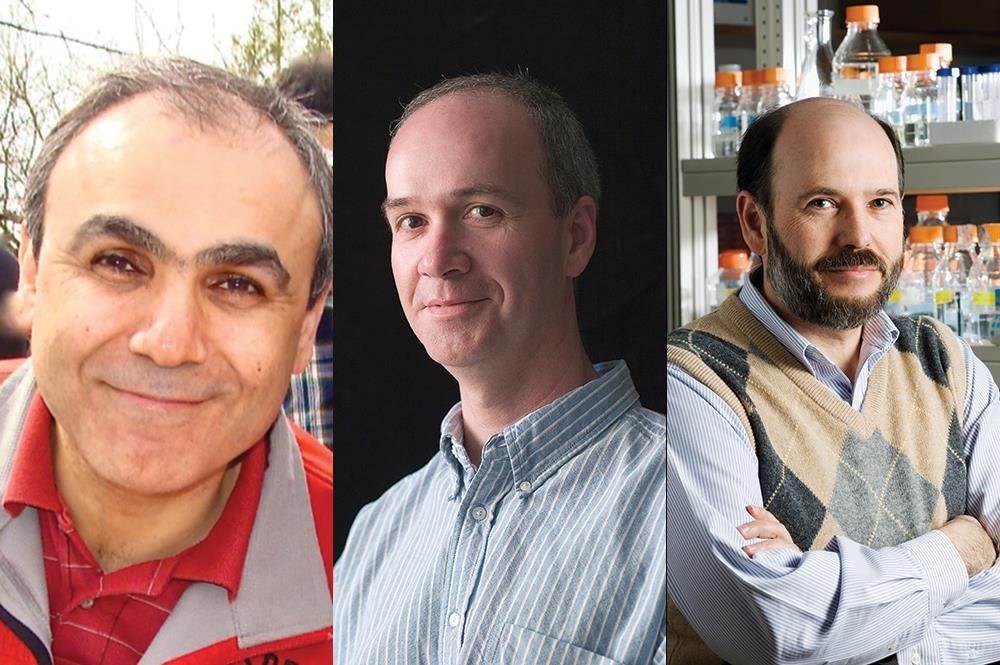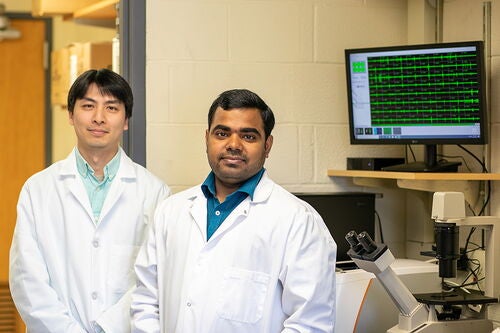The heart of discovery

Where does a medical breakthrough begin? At the University of Illinois, where many mysteries of human health are solved, more often than not the answer is this: In the laboratories of the College of LAS.
“LAS is where the basic medical research impacting human health is being done” on campus, said Stephen Sligar, director of the School of Molecular and Cellular Biology (MCB), Swanlund Chair, and professor of biochemistry, chemistry, and biophysics and computational biology.
Aside from raw numbers (see below), the truth of Sligar’s statement is evident in the myriad stories of health research coming out of the college. Here are just a few prominent examples:
Genome mining for a cure
One of the best ways to locate a needle in a haystack is to make your haystack smaller—and that’s exactly what Wilfred van der Donk and William Metcalf have done with a dramatic new alternative approach to discovering new pharmaceutical drugs.
The system is called “genome mining,” said van der Donk, the Richard E. Heckert Endowed Chair in Chemistry. Instead of screening thousands of strains of bacteria to find a few capable of creating new drug compounds, researchers look for the genes behind this ability. By hunting for the genes, scientists can narrow their search dramatically.
In 2015, van der Donk and Metcalf, the G. Williams Arends Professor in Molecular and Cellular Biology and professor of microbiology, were able to narrow down 8,000 strains of bacteria to a smaller pool of 350, which were capable of producing phosphonates.
Van der Donk—who is also a Howard Hughes Medical Institute investigator, an award given to those doing top medical science research—said that a “remarkably high percentage of phosphonates” have made it to commercial use, either as antibiotics in medicine or as innovative pesticides in agriculture. But in recent years, the cost of discovery has been a major obstacle to finding new antibiotics from natural molecules such as phosphonates. Genome mining could break through this barrier because it is faster than traditional approaches.
“About 95 percent of the bacteria that scientists spend their time screening are not making what they want,” van der Donk explains. “With genome mining, we can focus on the 5 percent.”
High risks and high rewards
To underscore the role of basic medical science funding in the college, three of its professors recently received a National Institutes of Health (NIH) transformative research award—one of only 12 given out across the country in the past year. This award, which is given to high-risk, high-reward research, has gone to a collaborative effort among Chad Rienstra in chemistry and Jim Morrissey and Emad Tajkhorshid in MCB.
The three professors are working on a creative new approach to studying cell membrane lipids known as phospholipids. Phospholipids interact with membrane proteins, which make up more than half of the targets for currently approved pharmaceuticals. But scientists have found it extremely difficult to study the interaction between membrane proteins and phospholipids, limiting drug breakthroughs.

Morrissey, Rienstra, and Tajkhorshid believe they have come up with a solution to this problem. Morrissey’s lab uses economical and innovative ways to synthesize a particular phospholipid known as PS. Then Rienstra’s lab analyzes the lipid’s 3-D structure using new approaches to nuclear magnetic resonance spectroscopy. Finally, Tajkhorshid’s lab runs computer simulations of the interaction between lipids and membrane proteins.
NIH has given them the five-year task of coming up with a toolbox of methods that scientists around the world can use to study such interactions. Understanding how membrane proteins interact with phospholipids will open all sorts of new drug possibilities, Morrissey said. For instance, it will help in the hunt for new anticoagulants— “blood thinners,” as they are popularly known.
When a blood vessel is cut and bleeding begins, cells are damaged. As a result, the lipids, which are normally inside the cell, move to the outside. Blood-clotting proteins circulating in the blood then detect these lipids and bind to them, setting off a chain reaction that causes the blood to coagulate.
By understanding how this process works, pharmaceutical companies may be able to develop more effective and less risky anticoagulants for patients who take them to prevent dangerous blood clots. Blood thinners slow down clotting, but they have the potential side effect of excessive bleeding. Researchers are on the hunt for anticoagulants with fewer bleeding risks.
“This is the most exciting science I have done in a long, long time,” Morrissey says.
The single investigator model—and major discoveries
Sligar was recently given a Maximizing Investigators’ Research Award (MIRA) from NIH, and van der Donk was given an NIH Merit award. Both awards allow researchers the freedom to explore new science with fewer strings attached.
Sligar has one of the longest connections with NIH on campus, because he has received continuous NIH funding going back to his professorial days at Yale University in 1977. He brought his NIH funding with him when he came to Illinois in 1982. Sligar is well known for developing the Nanodisc—a system for studying cell membrane proteins and lipids that is now used in hundreds of laboratories around the world.
The Nanodisc recreates a cell membrane in which to study biological processes, such as blood coagulation, cell migration, and cancer signaling. (Morrissey, Rienstra, and Tajkhorshid all use the Nanodisc in their collaborative project.)
“Today, my laboratory is very excited about using Nanodiscs to study a signaling complex formed by RAS,” Sligar said, referring to genes that play a pivotal role in cell signaling. “The RAS molecule is at the heart of many cancers.” In fact, he says, 97 percent of pancreatic cancers correlate with a mutation in the RAS gene.
A mutation in the RAS gene can turn off the cell death mechanism, which protects the body by preventing cells from multiplying out of control.
“If we can find a way of preventing the cell proliferation due to RAS and the associated signaling pathways, then we would have a cure for many cancers,” he said. “Interestingly, again it is the phospholipids that are critical, including those with phosphate groups on attached sugars such as PIP2 and PIP3.”
The phospholipid emphasis provides another connection between Sligar and the Morrissey-Rienstra-Tajkhorshid collaboration. Van der Donk, who serves on the council of the largest NIH institute for basic science, said this institute recently decided to focus more on individual investigator research, rather than large team efforts among multiple labs. Sligar said this is because the major discoveries that have improved human health throughout history, such as the discovery of antibiotics, were often made by a single-investigator-led team.
“Discovery is the fundamental thing, and that’s something we’ve done exceptionally well at Illinois since World War II. It’s what we’re famous for,” he said. “We all have a lot of crazy ideas and many of them don’t work, but a few turn out to be major discoveries.”
National Institutes of Health research grants
• Campus received more than $61 million in NIH research grants in 2016.
• LAS researchers (mostly in the School of Chemical Sciences and School of Molecular and Cellular Biology) received 49 percent of these grants.
• Interdisciplinary institutes (with LAS researchers making up the majority of these teams) received 27 percent of these grants.
Bound for the health industry
• Of the more than 1,700 students majoring in molecular and cellular biology, 79 percent declare themselves as pre-health (pre-medicine, pre-dentistry, pre-pharmaceutical, or pre-veterinary medicine).
• In 2013, roughly 59 percent of students accepted into medical school from the U of I campus majored in molecular and cellular biology or biochemistry. Another 23 percent came from other LAS majors.
*Editor's note: This story originally appeared in LAS News magazine (Spring 2017).








